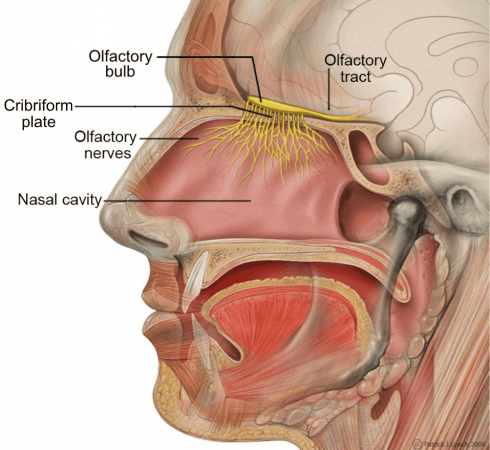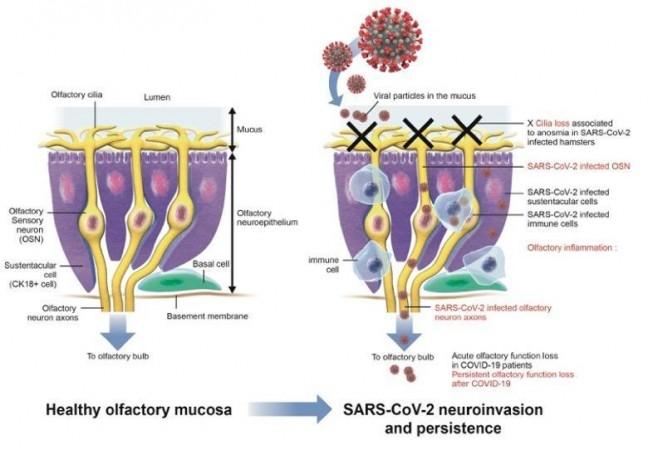One of the most common symptoms of COVID-19 is anosmia or the loss of smell. While it is known that patients suffer from both short-term and long-term anosmia, the mechanism used by the SARS-CoV-2 coronavirus to cause the condition has remained a mystery. Now, a new study has discovered the mechanism behind this unique symptom of the unpredictable viral infection.
The study is a collaboration between multiple French institutions. It discovered that the virus infects the sensory neurons and causes persistent inflammation of the epithelial cells within the nose and the olfactory nervous system (nerves within the nasal cavity).
"We observed that SARS-CoV-2 infects not only the sensory neurons, but also the olfactory nerve and the olfactory nerve centers in the brain," stated Dr. Pierre-Marie Lledo, co-author of the study, in a statement.
Losing Sense of Smell

While COVID-19 is known to primarily cause respiratory illness, several patients are known to exhibit symptoms that are non-respiratory. One such symptom that manifests itself at different stages of the disease is anosmia. Whether the virus is directly involved in the loss of smell has remained uncertain so far.
The commonly accepted hypothesis is that transient edema (inflammation of tissues due to fluid buildup) of the olfactory clefts (two narrow passages in the upper part of the nasal cavity) hampered the airflow carrying odor molecules to the olfactory neurons; a sensation that is familiar in the case of common-cold caused blocked nose.
Attacking the Olfactory System
To explain anosmia in COVID-19 patients, the authors conducted the current study with COVID-19 patients and supplement it with tests in animal models. The authors learnt that the process of loss of smell occurs in a series of steps. After being infected with novel coronavirus, the cilia (hair-like structure) on the sensory are lost. These cilia are responsible for the reception of odour molecules by the sensory neurons. Therefore, the virus is very much present in these neurons.

The resulting apoptosis or cell death, according to the team, is linked to the impeding of the olfactory epithelium's (specialized epithelial tissues within the nasal cavity) integrity. The epithelium, which is arranged as a thin layer or lamellae, is destroyed by the infection.
Next, the virus spreads to the olfactory bulb—the structure located in the forebrain that is involved in the process of smell and acts as a relay station for the olfactory system. Subsequently, several regions of the brain undergo inflammation and viral RNA is present in them.
"Another key finding from this study emerged from an observation of animal models, which revealed that once the virus enters the olfactory bulb, it spreads to other nerve structures, where it induces a major inflammatory response," explained Dr. Hervé Bourhy, co-author of the study.
A Gateway to the Brain

Based on the findings, the scientists remarked that the infection of the olfactory neurons may act as a gateway for the SARS-CoV-2 coronavirus to the brain. This could also serve as an explanation for why certain individuals develop several neurological symptoms (cognitive decline and susceptibility to neurodegenerative disease) and psychological symptoms (depression and anxiety disorders). Nevertheless, further studies are required the team stated.
Another unexpected learning of the study was the potential for the lapse in the standard RT-PCR tests. According to the authors, the test may yield a negative result (testing negative for COVID-19) even if the coronavirus still exists at the back of the nasal cavity within the olfactory epithelium. Hence, the extraordinary finding suggests that nasal brushing could be employed along with PCR test in patients who experience anosmia.
"According to our results, loss of smell in COVID-19 may persists for several months in some patients and this persistence of clinical signs may be attributed to the persistence of the virus and inflammation in the olfactory mucosa," concluded Dr. Marc Lecuit, co-author of the study.







!['Abhishek will win national award': Abhishek Bachchan's poignant act will tug your heartstrings in slice of life emotional saga I Want To Talk [trailer review]](https://data1.ibtimes.co.in/en/full/805617/abhishek-will-win-national-award-abhishek-bachchans-poignant-act-will-tug-your-heartstrings.jpg?w=220&h=138)



